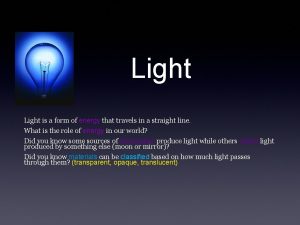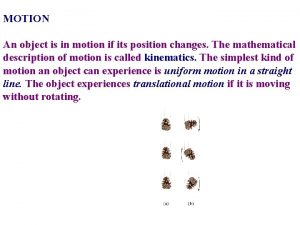Light travels in straight lines at a speed









- Slides: 9

Light travels in straight lines at a speed of just below 300 000 kilometres per second. Nothing else can reach this speed or travel faster than the speed of light. Light as a Wave

Light as a Wave �Unlike sound, light does not require particles (such as those found in water, air or gas) to travel through. This means that light can pass through the vacuum of space while sound cannot. Light can do this because it transmits energy as a special type of wave—an electromagnetic wave.

Two kinds of waves �Classified as either transverse or longitudinal

Longitudinal Waves

Visible light �The visible spectrum is the red, orange, yellow, green, blue, indigo and violet (ROYGBIV) seen in the rainbow. Each colour has a different wavelength and a different frequency. �Special cells called cones in the retinas of the eyes respond to different wavelengths and determine which colours are seen.

Visible Light - Wavelengths

The Electromagnetic Spectrum

Explosions in space �In sci-fi movies, explosions in space are usually incorrectly shown as being bright and noisy. �Although light can pass through a vacuum, sound cannot. �Explosions in space are bright and visible but completely silent.

Jam session beneath the sea � Underwater seems to be a very quiet place to humans but this is because our ears are normally full of water. � Divers often hear constant cracking when in the sea. Although it sounds like bacon cooking, it is actually the sound of shrimp cracking their claws, forming a small bubble that then ‘pops’. � Scientists from Curtin University of WA have recorded thousands of underwater sounds. � Shrimp, fish and sea urchins form loud choruses. Some sound like electric guitars, while others sound like chainsaws, monkeys, lightning storms or a lion’s growl. It’s noisy because sound travels further in water than it does in air.
 Light travels in a straight line
Light travels in a straight line Is a form of energy that travels in a straight line
Is a form of energy that travels in a straight line Method of heat transfer
Method of heat transfer Light travels 3 00 000 km/s. is it velocity or speed
Light travels 3 00 000 km/s. is it velocity or speed A snowmobile travels in a straight line
A snowmobile travels in a straight line An object travels back and forth along a straight line
An object travels back and forth along a straight line Light light light chapter 23
Light light light chapter 23 Light light light chapter 22
Light light light chapter 22 Chapter 22
Chapter 22 A ray of light travels from an optical denser
A ray of light travels from an optical denser
















